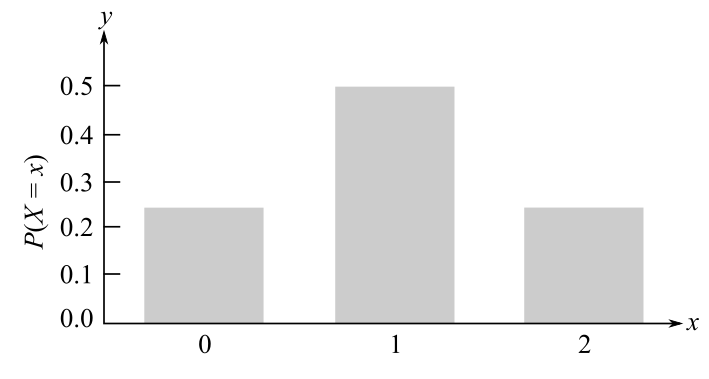
Concept explainers
To calculate: The probability distribution for the random variable X, if there is a couple that has two children and X is a number of boys, assuming that the chances of a child being a boy or a girl are same.
Answer to Problem 1RE
Solution:
The probability distribution for a number of boys is:
Explanation of Solution
Given Information:
There is a couple that has two children and X is a number of boys, assuming that the chances of a child being a boy or a girl are the same.
Formula Used:
If n is the number of trials and X is the number of successes, then the probability for a particular value of X is given by:
Calculation:
Consider the number of children
Evaluate the probability of success which is the probability of a boy.
Evaluate the probability of failure which is the probability of a girl.
Possible values of X being a boy child are
Now estimate the probability of each value of n by applying the formula
Evaluate the probability
Evaluate the probability
Evaluate the probability
The probability distribution for the number of boys is,
Graph:
The steps to draw the histogram of the binomial distribution is
Step 1: Place x values on the horizontal axis.
Step2. Place the value of probability
Step3. Construct a bar over each value of x extending from
Draw the graph of the binomial distribution as follows:

Interpretation:
The histogram of the probability distribution of a boy child out of two children where the probability of selecting a girl or boy child is equal.
Want to see more full solutions like this?
Chapter 9 Solutions
Finite Mathematics and Application Calculus (Looseleaf) - Text Only
- i don't understand how to get these answers please help!arrow_forwardEnter your answer in interval notation. No decimal entries allowed. Type oo (lower case o) for ∞ and -oo for -∞ if needed. Domain: Question Help: Message instructorarrow_forwardWrite a formula for the function g that results when the graph of the function f(x) = = 4 X is reflected about the y-axis, horizontally compressed by a factor of 2, shifted 7 units left, reflected about the x-axis and shifted 3 units up. g(x): = Question Help: Message instructorarrow_forward
- Question 7 4 pts 1 Details The value of China's exports of automobiles and parts (in billions of dollars) is approximately f(x) = 1.8208e0.3387x, where x = 0 corresponds to 1998. In what year did/will the exports reach $10.4 billion?arrow_forwardQuestion 7 4 pts 1 Detai The value of China's exports of automobiles and parts (in billions of dollars) is approximately f(x) = 1.8208e 0.3387x, where x = 0 corresponds to 1998. In what year did/will the exports reach $10.4 billion?arrow_forwardWrite a formula for the function g that results when the graph of the function f(x) = = 4 X is reflected about the y-axis, horizontally compressed by a factor of 2, shifted 7 units left, reflected about the x-axis and shifted 3 units up. g(x) = Question Help: Message instructorarrow_forward
- Question 3 Use the graph of f to evaluate the following: 3 pts 1 D 6 f(x) 5 4 3 2 1 -1 1 2 3 4 5 เค -1 x The average rate of change of f from 1 to 4 =arrow_forwardB Find the domain the function graphed below. Express in interval notation 5 3 pts 1 De 3 2 1 -5 -4 -3 2 -1 2 3 4 5 -2 -3 -4 5 Domain:arrow_forwardFind the domain the function graphed below. Express in interval notation 3 2 -5 4-3 12 -1 1 2 3 4 2 -3- 4 5+ Domain: Question Help: Message instructor Question 3arrow_forward
 Holt Mcdougal Larson Pre-algebra: Student Edition...AlgebraISBN:9780547587776Author:HOLT MCDOUGALPublisher:HOLT MCDOUGAL
Holt Mcdougal Larson Pre-algebra: Student Edition...AlgebraISBN:9780547587776Author:HOLT MCDOUGALPublisher:HOLT MCDOUGAL
